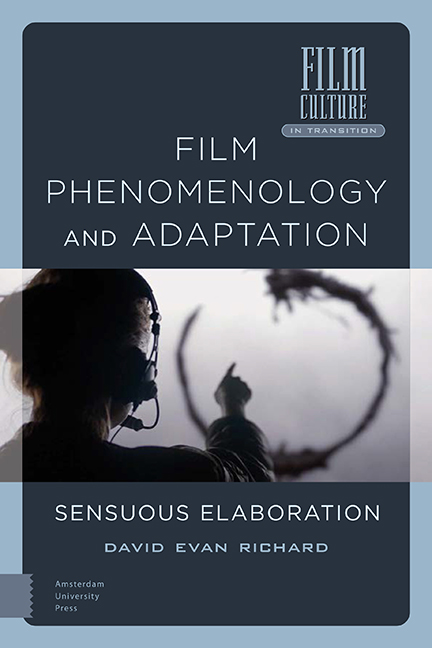Book contents
- Frontmatter
- Contents
- Acknowledgements
- List of Figures
- Introduction: A ‘Fleshly Dialogue’
- 1 Grave Visions: Visual Experience and Adaptation
- 2 Resonance and Reverberation: Sounding Out Screen Adaptation
- 3 Textural Analysis: Touching Adaptation
- 4 Textures of Imagination
- 5 (Re-)Mediating Memory’s Materiality
- Conclusion: Body Language
- Bibliography
- Filmography
- Index
Conclusion: Body Language
Published online by Cambridge University Press: 27 May 2021
- Frontmatter
- Contents
- Acknowledgements
- List of Figures
- Introduction: A ‘Fleshly Dialogue’
- 1 Grave Visions: Visual Experience and Adaptation
- 2 Resonance and Reverberation: Sounding Out Screen Adaptation
- 3 Textural Analysis: Touching Adaptation
- 4 Textures of Imagination
- 5 (Re-)Mediating Memory’s Materiality
- Conclusion: Body Language
- Bibliography
- Filmography
- Index
Summary
Abstract
The conclusion of the book re-examines the value of film-phenomenology in the evaluation and appreciation of film adaptation. I argue that before we make sense of an adaptation we must first attend to their sensual experience: their sight, their sound, their feeling, and how they are groped in embodied structures of imagination and memory. The conclusion fleshes out how an aesthetics of adaptation is inherently tied up with an ethics of adaptation, and gestures towards future work that needs to be done.
Keywords: adaptation, phenomenology, embodiment, ethics, Arrival (Denis Villeneuve, 2016), 12 Years a Slave (Steve McQueen, 2013)
Arriving at an Embodied Theory of Adaptation
Approaching adaptation—as a process, a product, and indeed a discipline—is a challenging task. As much as scholars attempt to pin it down with a dazzling array of interests, perspectives, and theories, adaptation seems to slip out of grasp. Kamilla Elliott, with expected rigour and clarity, has recently argued that adaptation actively resists theorization which are both ‘rival, overlapping, mutually resistant, cultural processes each vying to subject the other to their operations’. As she puts it:
‘theorization […] resists adaptation when it fails to conform to its tenets, denigrating, opposing, and ignoring it; even so, adaptation continues to resist theorization, blithely surviving and thriving in culture and practice, even when theorization pronounces it to be a theoretical impossibility, offending theorists as it promiscuously shifts theoretical allegiances, never fully aligning itself to any’ (p. 176).
Also assisting the disciplinary slipperiness of adaptation is the vast forms of texts, objects, and practices that are considered through the lens of adaptation, with each bringing its own critical traditions. Although film and theatrical adaptations form the bulk of adaptation criticism, scholars are increasingly examining a dizzying range of cultural products—such as comic books, videogames, toys, new media, social media—and cultural practices, including GIFs and digital communication and fan participation. But what unites these diverse forms of adaptation is us: their beholder. It is our sensual grasp of an adaptation that becomes the grounds for making sense of them as adaptations. Further, embracing a sensual approach to adaptation recognizes not only adaptation as occurring between forms, but also the adaptation of sense modalities as they criss-cross in the embodied imagination. As Elliott has put it, a synaesthetic approach to adaptation unites perception with conception, and ‘[what] theorization has torn asunder, let synaesthesia join together’.
- Type
- Chapter
- Information
- Film Phenomenology and AdaptationSensuous Elaboration, pp. 203 - 226Publisher: Amsterdam University PressPrint publication year: 2021



